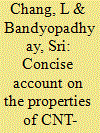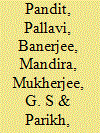|
|
|
Sort Order |
|
|
|
Items / Page
|
|
|
|
|
|
|
| Srl | Item |
| 1 |
ID:
130748


|
|
|
|
|
| Publication |
2014.
|
| Summary/Abstract |
Recently it has been reported in the technical literature that carbon nanotubes (CNTs) have distinct effects on thermal, mechanical and electric properties of epoxy resins. Compared to single-walled nanotubes (SWCNT), multiwalled nanotubes (MWCNT) apparently show greater improvements. The maximum aspect ratio (L/D) of CNT is reportedly as high as 138,000,000. In addition, the carbon nanotubes when treated with surface modifier to generate functional groups on their surface can afford to provide better improvement of the properties of the epoxy based CNT-particulate composite system. There are a number of factors that can influence the properties of epoxy-CNT systems. This paper examined the technical contents from selective references and made an attempt to highlight the general understanding of the properties and performance of epoxy - CNT particulate composite systems
|
|
|
|
|
|
|
|
|
|
|
|
|
|
|
|
| 2 |
ID:
053854


|
|
|
| 3 |
ID:
130749


|
|
|
|
|
| Publication |
2014.
|
| Summary/Abstract |
Poly (L lactic acid) (PLLA) ultrathin films of various thicknesses were prepared by spin coating method and investigated by using vibrational spectroscopic techniques such as FTIR and Raman. The analysis has been done in two parts: first one is verification of structural mode to understand the visibility of characteristic band to confirm the PLLA structure; where interestingly, as the thickness of the film increased, the structural features were found to be more explicit. The second part of the study was to observe the features of the film having been annealed for 1 h in two separate temperatures, one at specific annealing temperature 120 °C and the other at 160 °C to enable PLLA chains to reorient to get crystallized from its soften state at two such specific temperatures. The isothermal crystallization behavior of PLLA film at 120 °C and 160 °C from the melt was monitored by FTIR as well as Raman spectroscopies. More importantly, the band at 921 cm-1 corresponds to ? crystalline phase of PLLA has been observed even in this ultrathin film with the effective application of temperature as selected in this study.
|
|
|
|
|
|
|
|
|
|
|
|
|
|
|
|
| 4 |
ID:
130743


|
|
|
|
|
| Publication |
2014.
|
| Summary/Abstract |
In this paper, we report the embedment of Cobalt (Co) nanoparticles by ion beam sputtering (IBS) in poly(vinylalcohol) (PVA) substrate to prepare nano composite film. The Co film of 5 nm was deposited on PVA by IBStechnique. Formation of Nano crystalline Co with HCP phase is revealed in GIXRD pattern of the film which alsoindicates that there is no change in the crystalline structure of PVA even after sputtering of the metallic nanoparticles.The average particle size of Co nanoparticles as evaluated using Scherer formula is found to be about 2 nm. UVVisabsorption spectrum of the film showed SPR peaks of Co metal in their nano size level embedded in the PVAmatrix system. XPS study confirms the metallic nature of Co MOKE studies show that the nanocomposite film isferromagnetic with HcÐÐ of. 42.8 Oe.
|
|
|
|
|
|
|
|
|
|
|
|
|
|
|
|
| 5 |
ID:
130750


|
|
Quantitative analysis of curing mechanisms of epoxy resin by mi
/ Cholake, Sagar T; Mada, Mykanth R; Raman, R.K. Singh; Bai, Yu, Zhao, Xl, Rizkalla, Sami, Bandyopadhyay, Sri
|

|
|
|
|
| Publication |
2014.
|
| Summary/Abstract |
This article informs the essence of major work done by a number of researchers on the analysis of two-step curing mechanism of diglycidyl ether of bisphenol A (DGEBA) epoxy resin in presence of amine curing agents using near- and mid-IR technology. Various peaks used as a marker for resin formation are discussed and their implementation is comprehensively studied. In addition to this, a wide range of information about the importance of reference peaks in both near-IR (NIR) and mid-IR (MIR) regions are congregated and their accuracy is audited. Also discrepancies observed by researchers in epoxy conversion (?) in NIR and MIR regions are reviewed to highlight the comparative advantages of both regions, one over the other.
|
|
|
|
|
|
|
|
|
|
|
|
|
|
|
|
| 6 |
ID:
130746


|
|
|
|
|
| Publication |
2014.
|
| Summary/Abstract |
It is believed that addition of small amount of nanoclays in the neat epoxy and fiber reinforced epoxy composite system can improve the mechanical properties. The mechanical properties of most of polymer matrix composites are sensitive to testing rate. However, most of the researches were concentrated on the behavior of the polymer
matrix composites at high strain rates. The present research work is to investigate the role of clay on neat epoxy and glass-fiber reinforced epoxy composites, at low strain rates. The clay in terms of 1.5 wt%, 3 wt%, and 5 wt% are dispersed in the epoxy resin using mechanical stirring followed by sonication process. The corresponding glass/epoxy nanocomposites are prepared by impregnating the clay epoxy mixture by hand lay-up process. Characterization of the nanoclay is done by X-ray diffraction and Scanning Electron Microscopy. Tensile stress-strain curves are obtained at strain rates of 10-4 s-1, 10-3 s-1, 10-2 s-1, and 10-1 s-1 by a hydraulic machine reporting that, even at low strain rates, the longitudinal strength and stiffness increase as strain rate increases for all clay loadings. It is observed that the tensile modulus increases as the clay loading increases for both epoxy and glass/epoxy nanocomposites. It is also noticed that the longitudinal tensile strength decreases as the clay loading increases. The failed specimens show marked changes in the fracture surface with increased strain rate. Scanning electron microscopy is used to study the fiber/matrix/clay adhesion in fracture surfaces.
|
|
|
|
|
|
|
|
|
|
|
|
|
|
|
|
|
|
|
|
|